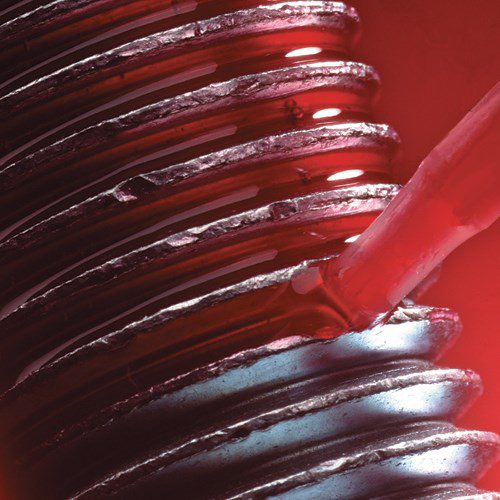If you do assembly work long enough, you will be faced with this question sooner or later: “Should I use a thread locking liquid on this bolt?”
Thread locking fluid prevents loosening of the fasteners in your assembly during operation. It works like glue by filling the gaps between the threads in the part and the threads on the bolt. It also protects the threads of the bolt by making sure it stays in place.
There are four strengths and several different brands (e.g. Loctite, Hernon Nuts N’ Bolts, Permatex, etc.) to choose from. When you are picking the strength of the bolt thread lock, you need to determine the function of your application and the need to remove the hardware.
Here are some guidelines to follow to help determine which strength to use for different applications:
• PURPLE THREAD LOCK – A low-strength threadlocker, it is most commonly used in light assembly applications and on hardware such as set screws and bolts up to 1/4”or M6. It works well in applications that have light vibration or when you might have to make some adjustments later. Typically with this strength, the bolt will still be able to be removed with hand tools after the product has been allowed to cure.
• BLUE THREAD LOCK – This medium strength threadlocker is like the purple thread lock when used on hardware larger than 1/4”. It is best used in places with medium vibration and on bolts that typically don’t need to be removed or adjusted routinely. Metaltech Products, Inc. (MPI) recommends using it on hardware larger than 1/4” up to ¾” or 20mm. Avoid using this strength on set screws, fine threaded bolts, or specialty headed bolts such as Allen Heads, Torx, and Phillips head screws because you might strip out the head or cause damage to the threads, sacrificing the integrity of the assembly. On larger bolts you will be able to remove the hardware with hand tools after the product has been allowed to cure.
• RED THREAD LOCK – This high-strength threadlocker should only be used on hardware that you don’t want to remove. Typically, you will have to use mechanical tools to remove the hardware after the product has cured. Use it on hardware larger than 1-1/16” or 27mm.
• GREEN THREAD LOCKER- Penetrating strength. This should only be used when you DO NOT want to remove the bolt. You will have to use heat to break the bolt free. This liquid is very aggressive and will eat into the metal. By doing so, it will make a very strong bond with the bolt and the parts the bolts are threaded into.
The use of thread locking fluid can become a great debate around the shop if you’re not careful. It has been MPI’s experience that you first must look at all parts of your application to determine if thread locking liquid should be used.
The use of bolt thread lock is determined by the type of hardware used in conjunction with the customer needs, and the intended use of the products.
Check out our blog for more industrial use cases!
For information about our parts fabrication services, please contact us at (417) 426-5577, or email us at [email protected].
Mark Newell, Metaltech Products, Inc.





